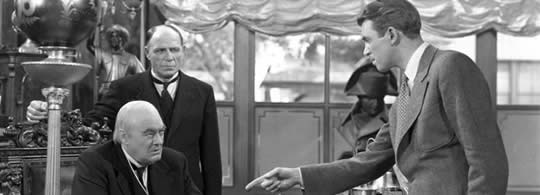Build Loyalty like George Bailey
In the movie It’s a Wonderful Life, businessman George Bailey shifts from despair to intense motivation when an angel intervenes to show him how much worse off his town would have been without him. Most of us don’t have a guardian angel named Clarence to show us alternative histories, but it turns out that imagining “what if” scenarios is a powerful tool in real life.
Loyalty is an important commodity. Businesses want loyal employees. Marketers want loyal customers. Generally, loyalty is earned over time, but it turns out that feelings of loyalty can be increased in a rather simple way. Researchers at Northwestern University and UC Berkeley led by Hal Ersner-Hershfield found that having subjects visualize historical alternatives made them more patriotic. Similarly, reflecting on the shaky origins of a company made its employees more positive about the firm.
The researchers ran a series of tests. Subjects were asked to reflect on how the US came into being. Half of the subjects were asked to reflect on what their world would be like if the country hadn’t come into being. (This is called “counterfactual reflection.”) The other half were told to think about what their world is like because the country did come into existence (factual reflection). The subjects who were told to imagine the “what if the country hadn’t come into existence” scenario demonstrated higher levels of patriotism in subsequent testing than those that reflected on their actual situation.
And it’s not just patriotism that can be stirred by imagining alternate scenarios – it works for businesses, too. A similar test which had subjects reflect on the origins of a company showed a significant boost in positive feelings among those who thought about the counterfactual condition, i.e., the differences had the company NOT been created.
So what’s the neuromarketing takeaway for managers and marketers? I can see a variety of ways that counterfactual scenarios could be employed. A few examples:
What if the company hadn’t survived? Most companies have had some touch-and-go moments in their history. The authors of the study cite FedEx as a famous example – the company was almost out of cash when founder Fred Smith flew to a Las Vegas casino in a last-ditch attempt to generate enough funds to make payroll. Just about every company has some sort of story like that (though perhaps not quite as dramatic), and letting employees think about their situation had things not turned out as they did could boost feelings of loyalty.
What if you hadn’t joined our company? The researchers didn’t test this approach, but I think it likely that particularly for employees who have had positive experiences since being employed – promotions, pay increases, home or car purchases, etc. – reflecting on the company’s role in this and the alternative scenarios could amplify positive emotion toward the company.
What if you didn’t buy our product/service? Has a customer had a positive experience or received real benefits from the relationship? Has the customer reduced their cost or improved their efficiency? Have there been fewer delivery problems than with past vendors? Helping the customer visualize alternative scenarios would be one way to enhance their positive feelings about the relationship.
Use with caution. Clearly, there are a lot of ways a ham-handed approach to this technique could backfire. Call an employee into an office had tell him to “Think about how what your life would be like if you weren’t employed by us,” and the emotions generated won’t be positive. Similarly, telling a customer, “Imagine how screwed up your manufacturing schedule would be if you were still dealing with that unreliable supplier you used to use,” won’t earn come across as positive and professional.
My advice: be subtle in introducing alternative scenarios, and you will produce the desired positive boost in loyalty and emotion without alienating the other person. Or, hire an angel named Clarence. (I actually CAN imagine a successful company doing a Clarence-like video showing its positive impact on the community by visualizing what it would be like had the company not existed – fewer jobs, fewer homes, etc.)
Read the original study here: Company, country, connections: Counterfactual origins increase organizational commitment, patriotism, and social investment. Also, read the earlier study that proposed the “George Bailey effect” – It’s a Wonderful Life: Mentally Subtracting Positive Events Improves People’s Affective States, Contrary to Their Affective Forecasts.


This is especially interesting to me because it’s commonly stated that gratitude is a big contributor to overall life satisfaction and happiness. I started a gratitude journal about 6 months ago and I admit that it does help keep things in perspective.
I think the tricky part in this is just what you mention. How do you call a person’s attention to something they can be grateful for without being a little too direct about it?
For me, I have to make a practice of measuring ROI. That makes one aspect of it fairly straightforward because I can easily point out the lost opportunity cost if the company had chosen not to work with me.
I hadn’t heard of this research. Really interesting! It’s a great idea to use “counterfactual” narratives in marketing …and in internal communications …and when reflecting on life in general.
But the brilliance here is that you connected this to one of the all time great movies. Yes, the gift given to George Bailey was indeed a glimpse into the counterfactual. And it changed everything.
This is a great post, Roger. My only disagreement is very minor: you called loyalty a “commodity” which didn’t ring true for me.
Keep up the great stuff! I’ll be looking for ways to apply this lesson in my own marketing and in my company. Thanks again.